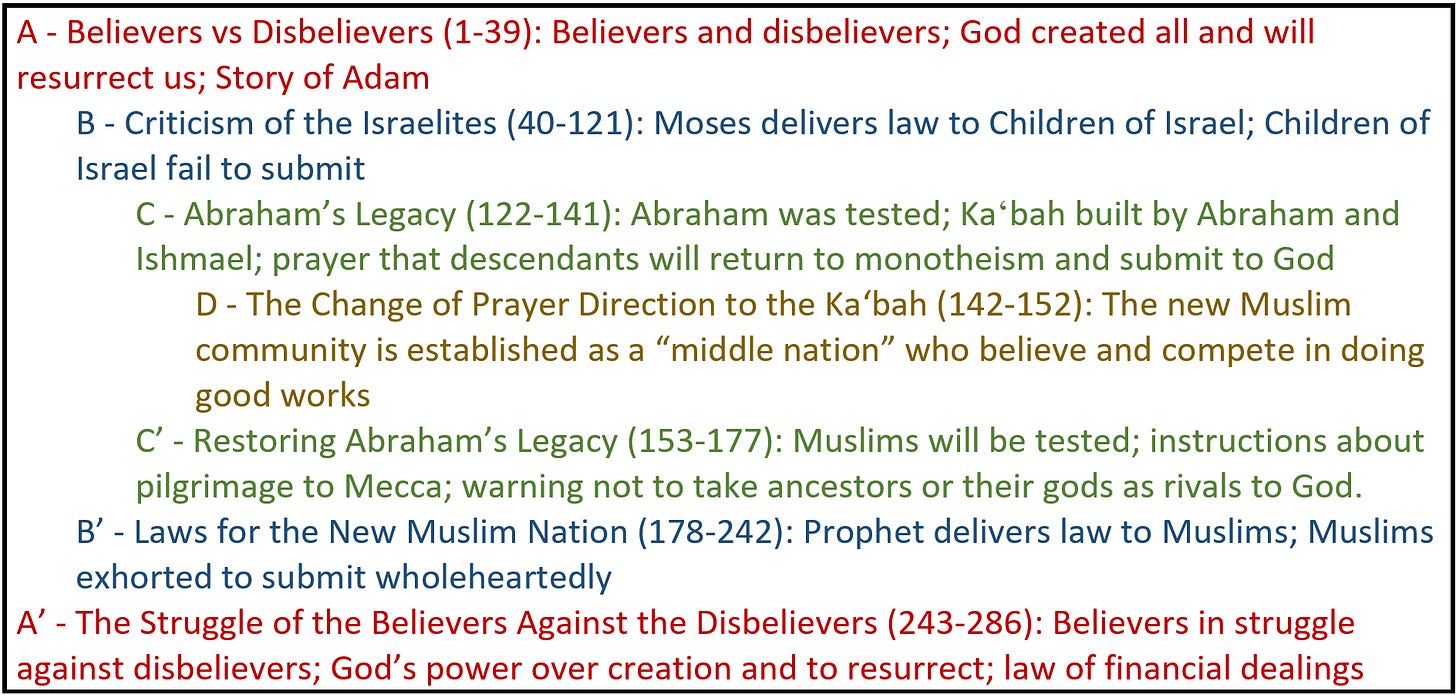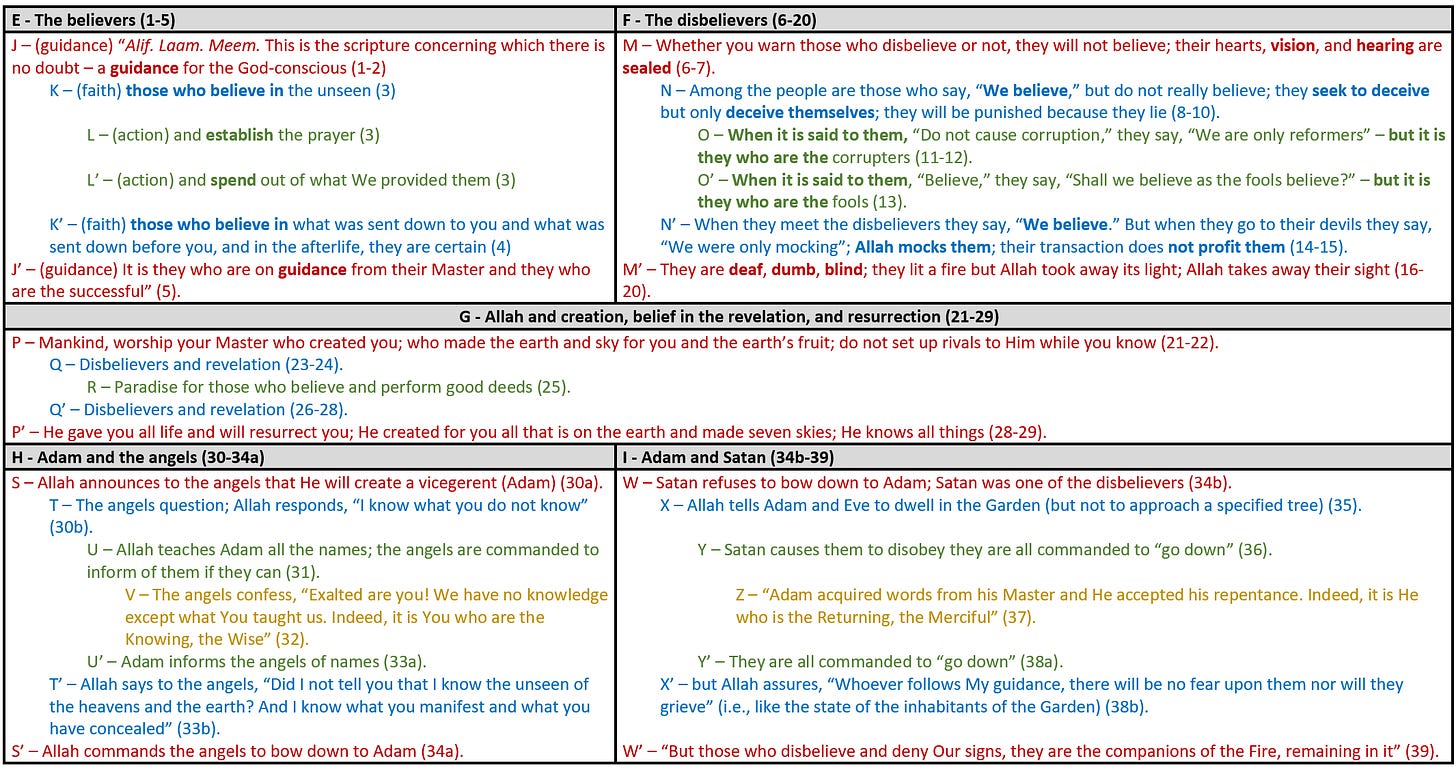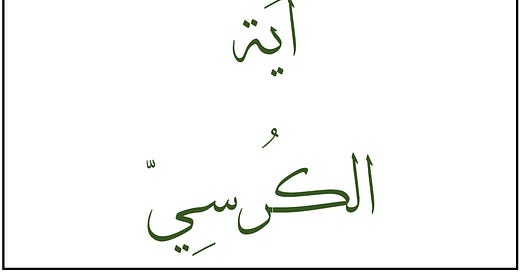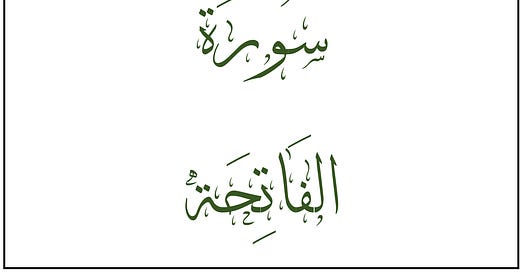

Discover more from Heavenly Order
The past couple weeks have focused on how the themes of Sūrah al-Fātiḥah have dovetailed seamlessly with Sūrah al-Baqarah (Part 1 and Part 2). Going forward, we will outline the overall structure of Sūrah al-Baqarah and explore the depth and complexity of its organization.
There are many approaches one could take when observing the structure of Sūrah al-Baqarah. Due to the length and complexity of this study, we are going to focus on the integrative and structural coherence of the forthcoming sections. While there have been studies on the linear coherence between each āyah of this sūrah, including those details would make for a near-endless series.
Because of the multiple layers of depth, it may be best to demonstrate the macro-structuring of the sūrah and break up the analysis based on each section therein. Much of the original Arabic will be omitted for brevity, though we will highlight the transliteration when we would like to demonstrate parallels in the Arabic vocabulary and grammar.
When the entire sūrah’s subject matter is summarized, it appears that the contents can be organized in a ring structure as shown below with the relevant āyah numbers shown in parenthesis:
We’ll revisit this ring towards the end of the series once we’ve delved a bit into each of the sections. The connections we make then will be easier to understand.
Integrative Coherence of Section [A]
To begin our study, we will focus on Section [A] - Believers vs Disbelievers (1-39). As mentioned earlier, we will outline the integrative coherence (how different āyāt, passages, or sections within a sūrah, or even between separate suwar, are interconnected by key terms, verbal roots, images, parallel expressions, or even sound patterns that they share. To simplify, we will call these unifying items anchors) first, and then observe the structure next.
The various parts of Section [A] are linked together by a profusion of anchors. The list below is just a sample. Observe how even seemingly separate topics or discussions are integrated by the use of anchors, drawing thematic connections between them. The relevant āyah numbers are shown in parenthesis after the translation:
“This is the scripture concerning which there is no doubt (rayb)” (2); “if you are in doubt (rayb) about what We have sent upon Our servant, then produce a sūrah of its like” (23).
“who believe in the unseen (ghayb) (3); “[Allah] said, ‘Did I not tell you that I know the unseen (ghayb) of the heavens and the earth?’” (33).
“it is they who are the fools, but they do not know (lā yaʿlamūn)” (13); “do not attribute rivals to Allah while you know (taʿlamūn) (22); “those who believe know (yaʿlamūna) it is the truth (26); “Indeed I know (aʿlamu) what you do not know (lā taʿlamūna) (30; cf. 29, 32-33); “and He taught (ʿallama) Adam the names, all of them” (31).
“who believe in what was sent down (unzila) to you and what was sent down (unzila) before you” (4); “and He sent down (anzala) water from the sky” (22); “if you are in doubt about what We have sent down (nazzalnā) to Our slave….” (23).
When it is said to them, ‘Do not cause corruption on the earth (lā tufsidū fīl arḍ)’ they say, ‘We are only reformers’” (11); “who break Allah’s covenant…and cause corruption on the earth (ufsidūna fīl arḍ)” (27); “When your Master said to the angels, ‘I will place on the earth (fīl arḍ) a vicegerent,’ they said, ‘ Will you place on it one who will cause corruption on it (ufsidūna fī-hā)…?’” (30)
“their example (mathal) is like one who kindles a fire” (17); “then produce a sūrah of its like (mithli-hī)” (23); “Allah is not timid to present an example (mathal)… but as for those who disbelieve, they say, ‘What does Allah intend by this as an example (mathal)?” (26)
“their example is like one who kindles (istawqada) a fire (nār)” (17); “fear the fire (nār) whose fuel (wuqūd) is men and stones” (24); “those are the Companions of the Fire (nār)” (39)
“they put their fingers in their ears.. fearing death (mawt) (19); “how can you disbelieve in Allah when you were lifeless (amwāt), then He gave you life, then He will cause you to die (yumītu-kum)” (28).
“and call your witnesses if you are truthful (in kuntum ṣādiqīn)” (23); “[Allah] said, ‘Tell me the names of these if you are truthful (in kumtum ṣādiqīn)’” (31)
“They will have gardens (jannāt)… and they will have purified spouses (azwāj)” (25); “We said, ‘O Adam, dwell you and your wife (zawj) in the Garden (al-jannah) (35).
“and they spend of what We have provided (razqnā) for them” (3); “and brought thereby fruits (thamarāt) as a provision (rizq) for you” (22); “whenever they are provided (ruziqū) a provision (rizq) from its fruit (thamarah) they will say, ‘This is what we were provided (ruziqnā) before’” (25)
This repetition of anchors shows that the section is a remarkably coherent network of overlapping terms and motifs, and serves to underscore subtle connections between seemingly disparate passages.
Symmetry of Section [A]
In addition to the integrative coherence of the section, it is beautifully organized into five mirror or ring compositions (click on the image to zoom in):
Looking horizontally, the two mirror structures at the beginning form complementary opposites ([E] - “The believers” vs. [F] - “The disbelievers”), as do the two at the end ([H] - “Adam and the angels” vs. [I] - “Adam and Satan”). Looking vertically, the two on the left side underscore the behavior of the faithful ([E] - “The believers” and [H] - “Adam and the angels”), and the two on the right side underscore the behavior of the disbelievers (“the disbelievers” and “Satan”). The ring in the center brings together the main themes of the Quran: monotheism and creation, faith and disbelief in the revelation, and the afterlife.
Take special notice of the messages that are highlighted by each of the mirror or ring structures. The first mirror structure ([E] - The believers) introduces the themes of guidance, faith, and righteous action (guidance itself consisting of faith and righteous action), while the second mirror ([F] - The disbelievers) is concerned with the opposite characteristics.
The third structure ([G] - Allah and creation, belief in the revelation, and resurrection), which is at the center of the entire section, is a ring, outlining the contents, attitudes, and consequences of faith and disbelief. At its own center, and hence the central āyah of the entire section, it draws attention to the reward in store for those who have faith and perform righteous actions.
The centers of the two bottom rings highlight the themes of faith and righteous deeds respectively. The quotation of the angels in the center of the bottom-left ring (āyah 32 of [H]) is an exclamation of faith (also note the emphasis on knowledge), and the names of Allah ﷻ that are mentioned in the āyah (“the Knowing” and “the Wise”) underscore why a person should invest such faith.
The allusion to Adam’s repentance in the center of the bottom-right ring (āyah 37 of ring [I]) highlights the action of the believer, and the divine names that are mentioned here underscore why a person should engage in virtuous acts like repentance: namely, that Allah ﷻ is “Returning” and “Merciful” towards those who do so.
Finally, the entire section is bracketed by the same key terms and themes, forming what is known as an inclusio or envelope structure:
والله أعلم - And Allah knows best
Sources
Ali Khan, Nouman and Sharif Randhawa. Divine Speech: Exploring the Quran as Literature. Bayyinah Institute, 2016
Amīn Aḥsan Iṣlāḥī, Tadabbur-e-Qur’ān: Pondering Over the Qur’ānm Volume 1: Tafsīr of Sūrah al-Fātiḥah and Sūrah al-Baqarah, trans. Mohammad Saleem Kayani (Kual Lampur: Islamic Book Trust, 2006), 526-527
Mustansir Mir, “The Sūra as a Unity: A Twentieth Century Development in Qur’an Exegesis” in Approaches to the Qur’an, eds. G. R. Hawting and Abdul-Kader A. Shareef, eds. (London: Routledge, 1993), 211-224
Robinson, Discovering the Qur’an, 201-223
A. H. Mathias Zahniser, “Major Transitions and Thematic Borders in Two Long Sūras: al-Baqara and al-Nisā’” in Literary Structures of Religious Meaning in the Qur’an, ed. Issa J. Boulatta (RichmondL Curzon, 2000)
Raymond Farrin, “Surat al-Baqara: A Structural Analysis,” Muslim World 100.1 (2010): 17-32
Nevin Rida El-Tehry, Textual Integrity and Coherence in the Qur’an: Repetition and Narrative Structure in Surat al-Baqara (PhD diss., University of Toronto, Toronto, 2010)
Farrin, Structure and Qur’anic Interpretation, 9-21
Subscribe to Heavenly Order
Exploring the Divine Structure and Coherence of the Quran. Join us as we dismantle the myth of the "disjointed" and "random" organization of Islam's Revealed Text.













